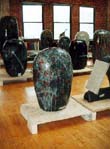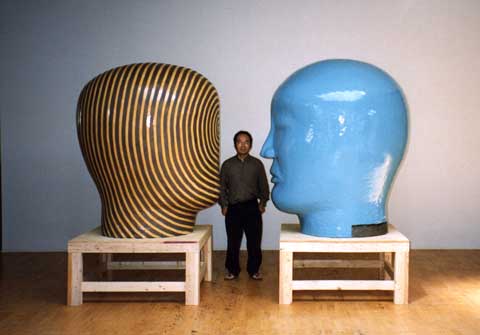|
|
|
|
|
|
|
|
|
|
|
|
|
|
|
|
|
|
|

|
Current Exhibitions Future Exhibitions Back to Exhibitions  Jun Kaneko studio, Omaha. Photo: © 2001 Tyler Museum of Art  Ceramic Forms and Painterly Surfaces exhibition, Tyler Museum of Art  Ceramic Forms and Painterly Surfaces exhibition, Tyler Museum of Art |
Ceramic Forms and Painterly Surfaces: The Recent Works of Jun Kaneko August 2–November 18, 2001  Jun Kaneko stands between Pair of Heads. Photo: © Paul Klein, Chicago The exhibition Ceramic Forms and Painterly Surfaces: The Recent Works of Jun Kaneko opened at the Tyler Museum of Art on August 2 and continued through November 18, 2001. The exhibition was organized by the Tyler Museum of Art and was curated by Kentaro Tomio. The Tyler Museum of Art was the only venue for the exhibition. Born in Nagoya, Japan in 1942, Jun Kaneko is recognized internationally as one of the foremost ceramic sculptors of our day. He is perhaps best known for his rounded, large-scale forms called dangos (after the Japanese word for steamed sweet dumplings). At times measuring more than eight feet tall and weighing 2,600 pounds, these monumental sculptures are considered one of the great achievements in modern ceramics, or for that matter, modern sculpture. They join an affinity for simplified form and surface pattern with technical excellence as required by the successful creation of such enormous ceramic works. Kaneko prefers forms such as ovals, spheres, triangles and rectangles which he hand builds in clay and then finishes by applying glaze and slip to their surfaces. The surface patterns are often free improvisations on traditional motifs—stripes, dots, spirals, zig-zag marks, and slashes. Often glazed in bright, bold colors, the dangos are inviting and playful on one hand, but there is a seriousness and complexity to them as well. Jun Kaneko began his art career as a painter. After studying in Japan from 1961 to 1963, he moved to Los Angeles to further his training. The day he arrived in California he met Fred and Mary Marer, and he agreed to house-sit for the couple while they went to Europe. This chance encounter changed Kaneko's life. Inside their home was one of the finest private collections of contemporary West Coast ceramics to be found anywhere. The collection included works by Peter Voulkos, John Mason, Henry Takemoto and others who have rightly been described as having enacted a revolution in clay. Kaneko was fascinated by what he saw and soon began working in ceramics. He studied with many of the top ceramic artists in the United States: Jerry Rothman, Ralph Bacerra, Paul Soldner, and Voulkos. This group of artists was largely responsible for the transition of ceramic art from its traditional associations as craft into an art form recognized as a vehicle for individual artistic expression. Kaneko later taught at two of the finest art schools in the United States—the Rhode Island School of Design (1973–75) and Cranbrook Academy of Art (1979–1986). Kaneko began as a painter and his preoccupations at first glance remain pictorial: color, pattern, the nature of the mark, figure-ground relationships, the play with the edge. But Kaneko is now a painter who is also a ceramist, someone who loves what ceramics can offer: physicality, durability, weight, special possibilities for color and surface effects. Even if his works do rely heavily on surface decoration, he has adapted to sculpture in remarkable fashion, learning to work in the round, think in terms of real rather than depicted volume, space, shadows and balance, and master a new set of technical and perceptual problems concerning scale. There were 13 works on display in this exhibition. Besides the aforementioned dangos, there was a magnificent large-scale Pair of Heads, several smaller-scale ceramic pieces, as well as an acrylic painting and three ink and oil stick drawings on rice paper. Particularly striking was a spectacular tile wall measuring 11 feet high by 30 feet wide, created out of individual ceramic tiles glazed in Kaneko's signature abstract patterning. Jun Kaneko now resides in Omaha, Nebraska, where he has his studio. His work has been acquired by such museums as the Philadelphia Museum of Art; the Detroit Institute of Art; the Los Angeles County Museum of Art, and the Japan Foundation, Tokyo. Major public art commissions appear across North America, Europe, and Japan. The Tyler Museum of Art is supported by its members, the City of Tyler, and Tyler Junior College. Additional support is provided by the Rogers Foundation, the Watson W. Wise Foundation, and the Junior League of Tyler. The Tyler Museum of Art is located on the east side of the Tyler Junior College campus at 1300 S. Mahon. Museum hours are 10:00 a.m. until 5:00 p.m. Tuesday through Saturday and 1:00 p.m. until 5:00 p.m. Sunday. The Museum is closed Mondays. |